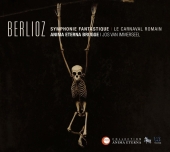| Label: Zig Zag
Catalog: ZZT100101
Format: CD Anima Eterna Brugge, conducted by Jos van ImmerseelHector Berlioz:
Symphonie fantastique / Le carnaval romain Gramophone Disc of the Month - May 2010
This monumental work of French Romanticism is one of the essential landmarks in the career of any conductor.
The quality of Berlioz’s orchestration and questions of timbre and the ideal instrumental
forces lie at the core of the approach of Jos van Immerseel and Anima Eterna Brugge, who are increasingly drawn to French composers and especially to their precise, shimmering orchestral textures. Surprisingly enough, it was the influence of the master orchestrator Rimsky-Korsakov on Ravel that made Jos van Immerseel want to tackle such pieces as Bolero and La Valse in a recording singled out by the press in 2006 for its hypnotic power and the quality of the timbres and phrasing.
Berlioz follows in this same line in 2010, with Poulenc planned for 2011 and Debussy for 2012.
It should be remembered that Jos van Immerseel was taught in Antwerp by Eugène Traye, himself a pupil of Robert Casadesus and chamber music partner of Jean Laurent and Arthur Grumiaux, in a highly Francophile musical tradition.
Over long months of preparation, the musicians steeped themselves in Berlioz’s music, his Treatise on instrumentation and his Memoirs, and gradually formed an image of the construction of this masterpiece in which poetry, imagination, lyricism, rhythmic invention and evocative power form the basis of a purely Romantic language of great subtlety.
The choice of period instruments (double basses from the period just after the instrument was modernised, French ‘omnitonic’ clarinets by Müller, ‘ordinary’ flutes from before the invention of the Boehm system, valved horns with crooks to avoid transposition, an ophicleide, an Érard harp, timpani with a central screw played with the sticks specifically called for by Berlioz, two Érard pianos to provide low harmonics in imitation of bells in the Dies irae of the Songe d’une nuit de sabbat), familiarity with Berlioz’s Treatise on instrumentation and Pierre Baillot’s L’Art de jouer du violon (notably with respect to vibrato), and respect for the composer’s dynamics constitute the principal bases for the sound world of this interpretation, which is at once refined in its Classical style and haunted by the pungent timbres of the brass and of those diabolical clarinets, abyssal bells, and rattling death-march timpani.
‘The result may be regarded as surprising and unexpected. Every moment of the performance testifies to the musical and technical mastery of the interpreters and their understanding of the grammar of this music, but also reflects their passion for and fascination with it.’  Price: $27.98 Price: $27.98 |
 Price: $27.98
Price: $27.98











